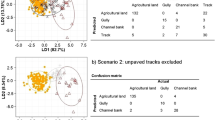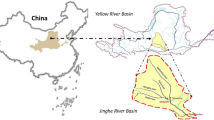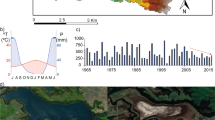Abstract
From 1985 onwards, South America has undergone a major expansion in agriculture at the expense of native vegetation (for example, native Pampa grassland). As an emblematic crop, the surface area cultivated with soybeans has increased by 1,000% between 1990 and 2020 in Uruguay. The environmental consequences of this massive land-use conversion on soil degradation remain poorly documented, although agriculture expansion is projected to continue to increase in the coming years in South America. In this study, sediment cores were collected in reservoirs located downstream of two contrasted agricultural catchments draining the Rio Negro River (Uruguay) to reconstruct the sediment dynamics and the sources of erosion associated with this expansion. Results demonstrated the occurrence of two periods of acceleration of sediment delivery since the 1980s. The first period of acceleration was recorded in the mid-1990s and was related to afforestation programs. The second and larger acceleration phase was recorded after 2000 during the soybean crop expansion. This period was marked by a greater supply of sediment from the native grassland source, highlighting the impact of agriculture expansion at the expense of native vegetation. Conservation measures should therefore be urgently taken to preserve biodiversity and soil functions in this region.
This is a preview of subscription content, access via your institution
Access options
Access Nature and 54 other Nature Portfolio journals
Get Nature+, our best-value online-access subscription
$29.99 / 30 days
cancel any time
Subscribe to this journal
Receive 12 digital issues and online access to articles
$119.00 per year
only $9.92 per issue
Buy this article
- Purchase on Springer Link
- Instant access to full article PDF
Prices may be subject to local taxes which are calculated during checkout




Similar content being viewed by others
Data availability
Data are available in the Zenodo repository at https://zenodo.org/record/6630369 and https://zenodo.org/record/6630479.
References
Tilman, D., Balzer, C., Hill, J. & Befort, B. L. Global food demand and the sustainable intensification of agriculture. Proc. Natl Acad. Sci. USA 108, 20260–20264 (2011).
Jaurena, M. et al. Native grasslands at the core: a new paradigm of intensification for the Campos of Southern South America to increase economic and environmental sustainability. Front. Sustain. Food Syst. 5, 547834 (2021).
Zalles, V. et al. Rapid expansion of human impact on natural land in South America since 1985. Sci. Adv. 7, eabg1620 (2021).
Song, X.-P. et al. Massive soybean expansion in South America since 2000 and implications for conservation. Nat. Sustain. 4, 784–792 (2021).
Encuesta Agrícola ‘Primavera 2007’ Serie Encuestas No. 257 (MGAP-DIEA, 2008).
Chiappe, M., Carambula, M. & Fernandez, E. El Campo Uruguayo: Una Mirada Desde La Sociologia Rural (Universidad de la Republica, 2008).
Peake, L. R. & Robb, C. The global standard bearers of soil governance. Soil Secur. 6, 100055 (2022).
García-Préchac, F. et al. in Global Degradation of Soil and Water Resources 77–92 (Springer Nature, 2022).
Alonso, J., Audicio, P., Martinez, L., Scavone, M. & Rezzano, E. Comparison of measured 137Cs data and USLE/ RUSLE simulated long-term erosion rates. Agrocienc. Urug. 16, 261–267 (2012).
Didoné, E. J., Minella, J. P. G. & Evrard, O. Measuring and modelling soil erosion and sediment yields in a large cultivated catchment under no-till of Southern Brazil. Soil Tillage Res. 174, 24–33 (2017).
Minella, J. P. G. et al. Long-term sediment yield from a small catchment in southern Brazil affected by land use and soil management changes. Hydrol. Process. 32, 200–211 (2018).
Tassano, M. et al. Evaluation of soil erosion and sediment sources in two contrasting sub-basins, using fingerprinting and 137Cs techniques in Uruguay. Preliminary results. EGU21 (2021).
Tiecher, T. et al. Fingerprinting sediment sources in a large agricultural catchment under no-tillage in Southern Brazil (Conceição River). Land Degrad. Dev. 29, 939–951 (2018).
Brazeiro, A., Achkar, M., Toranza, C. & Bartesaghi, L. Agricultural expansion in Uruguayan grasslands and priority areas for vertebrate and woody plant conservation. Ecol. Soc. (2020).
Laborde, A. et al. Children’s health in Latin America: the influence of environmental exposures. Environ. Health Perspect. 123, 201–209 (2015).
Vihervaara, P., Marjokorpi, A., Kumpula, T., Walls, M. & Kamppinen, M. Ecosystem services of fast-growing tree plantations: a case study on integrating social valuations with land-use changes in Uruguay. Policy Econ. 14, 58–68 (2012).
Reichert, J. M., de Deus Junior, J. C., Borges Junior, N. & Cavalcante, R. B. L. Experimental catchments in the Pampa biome: database on hydrology in grasslands and eucalyptus plantations in subtropical Brazil. Hydrol. Process. 35, e14285 (2021).
Ramon, R. et al. Combining spectroscopy and magnetism with geochemical tracers to improve the discrimination of sediment sources in a homogeneous subtropical catchment. CATENA 3535, 104800 (2020).
Foucher, A. et al. Deciphering human and climatic controls on soil erosion in intensively cultivated landscapes after 1950 (Loire Valley, France). Anthropocene 34, 100287 (2021).
Bajard, M. et al. Erosion record in Lake La Thuile sediments (Prealps, France): evidence of montane landscape dynamics throughout the Holocene. Holocene 26, 350–364 (2015).
Baud, A., Jenny, J.-P., Francus, P. & Gregory-Eaves, I. Global acceleration of lake sediment accumulation rates associated with recent human population growth and land-use changes. J. Paleolimnol. 66, 453–467 (2021).
Sabatier, P. et al. Evidence of chlordecone resurrection by glyphosate in French West Indies. Environ. Sci. Technol. 55, 2296–2306 (2021).
Foucher, A. et al. Regional trends in eutrophication across the Loire river basin during the 20th century based on multi-proxy paleolimnological reconstructions. Agric. Ecosyst. Environ. 301, 107065 (2020).
Foucher, A., Chaboche, P., Sabatier, P. & Evrard, O. A worldwide meta-analysis (1977–2020) of sediment core dating using fallout radionuclides including 137Cs and 210Pbxs. Earth Syst. Sci. Data 13, 4951–4966 (2021).
Chaboche, P. et al. 240Pu/239Pu signatures allow refining the chronology of radionuclide fallout in South America. Sci. Total Environ. 843, 156943 (2022).
Terra, J. & García-Prèchac, F. Efecto de la Intensidad de Uso y Laboreo Sobre el Recurso Suelo y su Calidad in Terra (INIA, 2001).
Polla, M. C. agroforestería en Uruguay [1997] (Dirección de Recursos Forestales, FAO, accessed 14 April 2022); https://agris.fao.org/agris-search/search.do?recordID=US201300062307
Geary, T. F. Afforestation in Uruguay: study of a changing landscape. J. For. 99, 35–39 (2001).
DIEA. Encuesta Agrícola “Invierno 2020” (Ministerio de Ganaderia, 2020).
Oliveira, A. H. et al. Water erosion in soils under eucalyptus forest as affected by development stages and management systems. Ciênc. Agrotecnol. 37, 159–169 (2013).
Valente, M. L. et al. Afforestation of degraded grasslands reduces sediment transport and may contribute to streamflow regulation in small catchments in the short-run. CATENA 204, 105371 (2021).
Redo, D. J., Aide, T. M., Clarck, M. L. & Andrade-Nunez, M. J. Impacts of internal and external policies on land change in Uruguay, 2001–2009. Environ. Conserv. 39, 122–131 (2012).
Zurbriggen, C. et al. Experimentation in the design of public policies: the Uruguayan soils conservation plans. Iberoam. Nord. J. Lat. Am. Caribb. Stud. 49, 52–62 (2020).
Mendez-Millan, M. et al. Compound-specific 13C and 14C measurements improve the understanding of soil organic matter dynamics. Biogeochemistry 118, 205–223 (2014).
Foucher, A. et al. Persistence of environmental DNA in cultivated soils: implication of this memory effect for reconstructing the dynamics of land use and cover changes. Sci. Rep. (2020).
Alexandratos, N. & Bruinsma, J. World Agriculture Towards 2030/2050: The 2012 Revision. FAO - ESA Working Paper No. 12-03 (FAO, 2012).
Nin-Pratt, A., Freiría, H. & Muñoz, G. Productivity and Efficiency in Grassland-Based Livestock Production in Latin America: The Cases of Uruguay and Paraguay (Inter-American Development Bank, 2019).
Mthimkhulu, S., Podwojewski, P., Hughes, J., Titshall, L. & Van Antwerpen, R. The effect of 72 years of sugarcane residues and fertilizer management on soil physico-chemical properties. Agric. Ecosyst. Environ. 225, 54–61 (2016).
Chalar, G., Gerhard, M., González-Piana, M. & Fabián, D. Hidroquímica y eutrofización en tres embalses subtropicales en cadena. In Procesos Geoquímicos Superficiales en Iberoamérica 121–148 (Sociedad Iberoamericana de Física y Química Ambiental (SiFyQA), 2014).
González-Piana, M. et al. Effects of wind mixing in a stratified water column on toxic cyanobacteria and microcystin-LR distribution in a subtropical reservoir. Bull. Environ. Contam. Toxicol. 101, 611–616 (2018).
Didoné, E. J. et al. Mobilization and transport of pesticides with runoff and suspended sediment during flooding events in an agricultural catchment of Southern Brazil. Environ. Sci. Pollut. Res. 28, 39370–39386 (2021).
Appleby, P. G. & Oldfield, F. The calculation of lead-210 dates assuming a constant rate of supply of unsupported 210Pb to the sediment. Catena 5, 1–8 (1978).
Bruel, R. & Sabatier, P. serac: an R package for ShortlivEd RAdionuclide chronology of recent sediment cores. J. Environ. Radioact. 225, 106449 (2020).
Croudace, I. W. & Rothwell, R. G. (eds) Micro-XRF Studies of Sediment Cores Developments in Paleoenvironmental Research 17 (Springer, 2015).
Ramon, R. Quantifying Sediment Source Contributions in Contrasted Agricultural Catchments (Uruguay River, Southern Brazil). PhD thesis, Univ. Paris-Saclay (2021).
Säumel, I., Ramírez, L. R., Tietjen, S., Barra, M. & Zagal, E. Back to the future - conservative grassland management for Anthropocene soils in the changed landscapes of Uruguay? Preprint at EGUsphere (2022).
Collins, A. L., Zhang, Y. & Walling, D. E. Apportioning sediment sources in a grassland dominated agricultural catchment in the UK using a new tracing framework. In Proc. ICCE Symposium. Sediment Dynamics for a Changing Future 337, 68–75 (IAHS, 2010).
R Development Core Team. R: A Language and Environment for Statistical Computing (R Foundation, 2020).
Batista, P. V. G. et al. Using pedological knowledge to improve sediment source apportionment in tropical environments. J. Soils Sediments 19, 3274–3289 (2019).
Acknowledgements
Collaboration between France and Uruguay was supported by an applied research project from the Fondo Maria Viñas (FMV_1_2019_1_156244 to M.T., G.C., M.C., J.G., P.C. and O.E.) funded by the National Agency of Research and Innovation (ANII, Uruguay). This work gave inspiration to the AVATAR project (ANR-22-CE93-0001).
Author information
Authors and Affiliations
Contributions
M.T., G.C., M.C., J.G. and P.C. collected the sediment cores. A.-C.S. and M.A. carried out CT-scan measurements. A.F. performed gamma and organic matter analyses as well as the XRF core scanner measurements. R.R. and T.T. developed the sediment tracing approach. A.F., P.-A. C. and O.E. drafted the manuscript. All authors participated in the editing and review of the manuscript.
Corresponding author
Ethics declarations
Competing interests
The authors declare no competing interests.
Peer review
Peer review information
Nature Sustainability thanks Pascal Podwojewski, Sebastian Villarino and Telmo Amado for their contribution to the peer review of this work.
Additional information
Publisher’s note Springer Nature remains neutral with regard to jurisdictional claims in published maps and institutional affiliations.
Supplementary information
Supplementary Information
Supplementary Figs. 1 and 2.
Rights and permissions
Springer Nature or its licensor (e.g. a society or other partner) holds exclusive rights to this article under a publishing agreement with the author(s) or other rightsholder(s); author self-archiving of the accepted manuscript version of this article is solely governed by the terms of such publishing agreement and applicable law.
About this article
Cite this article
Foucher, A., Tassano, M., Chaboche, PA. et al. Inexorable land degradation due to agriculture expansion in South American Pampa. Nat Sustain 6, 662–670 (2023). https://doi.org/10.1038/s41893-023-01074-z
Received:
Accepted:
Published:
Issue Date:
DOI: https://doi.org/10.1038/s41893-023-01074-z



